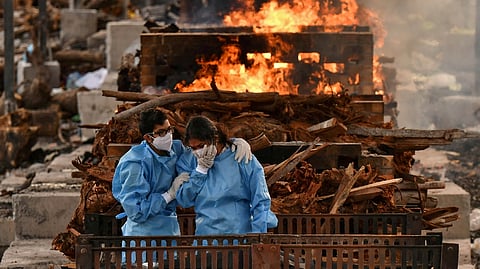

CHENNAI: The Parliamentary Standing Committee on Health and Family Welfare recently expressed its disappointment at the Health Ministry’s denial of COVID-19 deaths due to the shortage of oxygen. The Committee’s report highlighted that there were no definite guidelines for identifying deaths from inadequate supply of oxygen. The panel has instructed the Ministry to audit deaths due to the shortage of oxygen, especially during the second wave. The idea is to enable proper documentation of the mortalities to help disbursal of the appropriate compensation to survivors.
India’s official COVID count stood at about 4.45 crore cases. The fatalities stood at 5.28 lakh deaths, a little over 0.01%. However, India’s count of COVID-related fatalities has remained a bone of contention. When the pandemic had just begun in India in 2020, epidemiologists had estimated that there would be at least 10% fatalities among the total reported COVID cases here.
This is in line with the figures WHO offered in May this year when it said 47.4 lakh people in India had died during the pandemic in 2020 and 2021, which was ten times as much as the official fatality count. The WHO also highlighted that global fatalities, which is 1.5 crore deaths, could have occurred either directly or indirectly due to COVID. But, the Centre had repeatedly objected to the process and methodology employed by the WHO to arrive at this figure.
The government had countered these numbers by arguing that as there was the availability of the authentic data published by the Civil Registration System, by the Registrar General of India, mathematical models should not be relied upon to project excess deaths in India. It also pointed out how the WHO itself had admitted that data with respect to 17 States had been collated using information obtained from websites and media reports, which was a ‘statistically unsound’ and ‘scientifically questionable’ methodology.
In March, the Parliament was informed by the Minister of State for Health that not one State has reported a single death pertaining to the shortage of oxygen during the pandemic. The incredulity of this admission was not lost on those who ran from pillar to post during the second wave of the pandemic, as thousands gasped for breath across India. Ironically, the Ministry in its submission in 2020 had said India was self-sufficient vis-a-vis oxygen supply and cylinders.
In a prominent hospital in Delhi, 12 people died due to oxygen shortage and this included a doctor too. Similarly in a hospital in Tirupati, 23 patients died due to the delay in distribution of liquid medical oxygen (LMO). The unprecedented chaos prompted the government to import LMO as well as oxygen concentrators from abroad. It also led to the commissioning of as many as 3,756 Pressure Swing Adsorption (PSA) plants across India by March 2022. Under Phase II of the Emergency COVID Response Package, funds to install 950 LMO storage tanks with 1,359 medical gas pipeline systems were also offered to the States.
It would be unfair to brand such initiatives as too little, too late. But thousands of lives could have been saved had the Central and State governments anticipated the impact of the COVID wave. India must invest heavily in more resilient healthcare infrastructure that can sustain services during crises, and build stronger health information management systems to make optimum use of all those resources at hand.
Visit news.dtnext.in to explore our interactive epaper!
Download the DT Next app for more exciting features!
Click here for iOS
Click here for Android